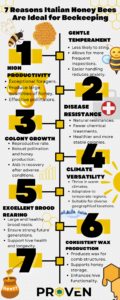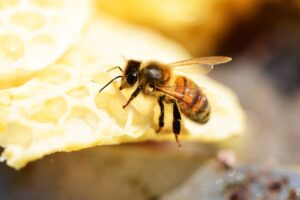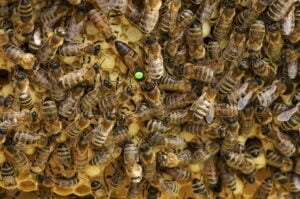Queen bees are the heart and soul of a hive, playing a crucial role in maintaining harmony and productivity within the colony. Their unique behaviors and biological functions significantly influence the hive’s dynamics, shaping everything from population control to social cohesion. In this article, we’ll explore six essential ways queen bees impact hive behavior and productivity, shedding light on their indispensable role in beekeeping. Understanding these facets is vital for beekeepers striving to foster healthy and thriving colonies, as it underscores the queen bee’s pivotal role in sustaining the hive’s ecosystem and ensuring its long-term viability.

Table of Contents
Queen Bees: The Regal Leaders of the Hive
Biological Superiority
Queen bees are biologically different from worker bees and drones. They have a larger body, a longer lifespan, and unique reproductive capabilities that enable them to lay thousands of eggs, ensuring the colony’s growth and survival. Their larger size is due to a specialized diet of royal jelly during their development, which also enhances their reproductive system, allowing them to mate with multiple drones and store sperm for years. This reproductive capacity and longevity make the queen bee the pivotal figure in maintaining the hive’s health and continuity.
Pheromone Production
One of the queen bee’s most vital functions is the production of pheromones. These chemical signals regulate various behaviors within the hive, including worker bee activities and hive cohesion. The queen bee’s pheromone communication ensures that worker bees know their roles, from foraging to brood care, and helps maintain a unified and efficient hive environment. This coordination is essential for the overall productivity and stability of the hive.
Reproductive Dominance
The queen bee’s primary role is reproduction. By laying a vast number of eggs daily, she ensures a constant supply of new bees, which is crucial for the hive’s maintenance and expansion. This egg laying capacity supports the hive’s population growth and replenishment, making the queen bee indispensable for the colony’s sustainability. The ability to continually produce new bees ensures that the hive remains robust and can adapt to environmental challenges, highlighting the critical importance of the queen bee’s reproductive role.
1. Egg Laying and Population Control
Sustained Egg Production
The queen bee’s remarkable ability to lay up to 2,000 eggs per day is fundamental to the hive’s survival and growth. This constant reproduction ensures a steady influx of new worker bees, which are essential for tasks such as foraging, nursing larvae, and maintaining the hive. The queen’s prolific capacity to lay eggs helps the colony rapidly recover from losses and sustain its workforce. Without this continuous replenishment, the hive would quickly decline in productivity and health. Therefore, the queen’s egg-laying is not just a biological function but a cornerstone of hive vitality.
Population Management
Queens strategically manage the hive’s population by selectively laying eggs that will develop into worker bees or drones, based on the colony’s needs. This selective process allows the queen to maintain an optimal balance within the hive, ensuring there are enough workers to support hive functions and enough drones for mating purposes. By controlling the population dynamics, the queen helps prevent issues such as overpopulation or underpopulation, which can disrupt the hive’s stability. This careful management is crucial for sustaining a healthy, productive, and well-balanced colony.
2. Pheromone Communication
Regulating Worker Behavior
The queen’s pheromones are powerful chemical signals that play a critical role in regulating the activities of worker bees. These pheromones influence various hive behaviors, including foraging, brood care, and hive maintenance, ensuring that the workers perform their tasks efficiently and in harmony. The presence of these chemical cues helps coordinate the efforts of thousands of bees, fostering a well-organized and functional hive. Without the queen’s pheromones, worker bees would lack the necessary guidance, leading to chaos and reduced productivity within the colony.
- Foraging: Queen pheromones direct worker bees to specific foraging areas, optimizing resource collection.
- Brood Care: Pheromones signal workers to attend to larvae and pupae, ensuring their proper development.
- Hive Maintenance: Chemical cues guide bees in tasks like hive cleaning, wax production, and nest repairs.
- Social Order: Pheromones maintain hierarchy, preventing worker bees from attempting to reproduce.
- Behavioral Synchronization: Signals synchronize worker activities, promoting efficient colony function.
Maintaining Hive Harmony
In addition to regulating worker behavior, the queen bee’s pheromones are essential for maintaining social harmony within the hive. These chemical signals prevent the development of rival queens by inhibiting the workers’ ability to rear new queens. This suppression of potential queen rearing ensures a single, uncontested ruler within the hive, which is vital for colony stability. The queen’s pheromones also promote cohesion and unity among the worker bees, minimizing conflicts and ensuring that the hive operates as a cohesive unit.
3. Swarm Prevention
Ultimate Swarm Prevention Guide: 12 Proven Beekeeper Tips
Preventing Overcrowding
The queen plays a pivotal role in preventing overcrowding within the hive through her egg-laying patterns. By selectively laying eggs and managing the hive’s population growth, she helps ensure that the colony does not exceed its spatial limits. Overcrowding can lead to resource depletion, increased stress, and ultimately, the swarming behavior, where a portion of the colony leaves to form a new hive. By preventing overcrowding, the queen maintains the hive’s optimal living conditions, reducing the likelihood of swarming and ensuring the colony’s stability.
Swarm Signals
When conditions within the hive become too cramped, the queen bee produces specific pheromones that signal the need to swarm. This pre-swarming communication allows the colony to prepare for the division, ensuring that the swarm can establish a new hive successfully. The queen’s pheromones coordinate the swarm’s timing and organization, facilitating a controlled and efficient dispersal. By managing the swarm process, the queen helps ensure the continued survival and expansion of the bee population, while also alleviating pressure within the original hive.
- Increased pheromone production: Queen bees emit higher levels of specific chemicals.
- Reduced egg production: Queen bees lay fewer eggs than usual.
- Presence of queen cells: Specialized cells housing potential new queens appear.
- Clustering at hive entrance: Bees gather in large numbers near the hive’s entrance.
- Honey consumption: Worker bees consume excess honey to prepare for relocation.
4. Genetic Diversity
Mating Practices
Queens engage in multiple mating flights with numerous drones, a practice that significantly enhances the genetic diversity of the hive. This diversity is critical for the colony’s health, as it reduces the likelihood of inbreeding and increases the genetic variability among the bees. A genetically diverse population is more resilient to diseases, environmental changes, and other stressors. The queen’s mating practices ensure that the hive has a broad genetic base, which contributes to its overall robustness and adaptability.

Genetic Influence
The queen bee’s genetic makeup has a profound impact on the entire colony, as her genes are passed on to all the offspring she produces. This genetic influence determines various traits within the hive, including the bees’ behavior, productivity, and disease resistance. A strong, healthy queen with desirable genetic traits can lead to a vigorous and efficient colony, while a weak queen can result in a decline in hive performance. Therefore, the queen’s genetics play a crucial role in shaping the hive’s success and sustainability.
5. Hive Morale and Productivity
Modern Honey Production: 12 Proven Methods to Boost Output
Worker Motivation
The presence of a healthy and active queen bee significantly boosts the morale of the worker bees, leading to higher productivity levels within the hive. Workers are more motivated to perform their tasks efficiently when guided by a strong queen, resulting in better foraging, brood care, and hive maintenance. This heightened motivation directly translates into increased honey production and overall hive health. The queen’s presence is thus a key factor in driving the workers’ dedication and ensuring the hive’s prosperity.
Disease Resistance
A robust queen bee contributes to the hive’s overall disease resistance through her genetic contributions and the healthy environment she promotes. Her pheromones and the stable social structure she maintains reduce stress within the hive, which in turn enhances the bees’ immune responses. Additionally, the genetic diversity resulting from the queen’s mating practices helps the colony withstand various pathogens and parasites. This improved disease resistance is crucial for the hive’s long-term survival and productivity.
6. Queen Replacement and Hive Stability
Successfully Introducing a New Queen – 12 Key Strategies
Instigating Queen Replacement
When a queen bee becomes aged or less productive, the hive initiates the process of raising a new queen to ensure continued stability and productivity. This replacement process, known as supersedure, is carefully managed by the worker bees, who select and rear new queen larvae. The successful transition to a new queen prevents disruptions in hive activities and maintains the colony’s overall health. The ability to replace the queen effectively is a testament to the hive’s resilience and adaptability.
Transition Management
The transition between an old queen and a new one is a critical period for the hive, requiring careful management to avoid instability. Finding the queen will be the first step in supporting this process. The worker bees facilitate a smooth transition by continuing their duties and supporting the new queen as she takes over. This seamless handover ensures that the hive’s productivity and cohesion are maintained without significant disruptions. A well-managed transition helps preserve the hive’s stability and ensures the continued success of the colony.

Additional Resources
Beginner’s Guide to Beekeeping: 8 Steps for Starting Your Journey
Understanding the 4 Life Stages of a Honey Bee Worker: Insights for Beekeepers
Honey Bees from the USDA
Conclusion
Understanding the role of the Queen Bee in influencing hive behavior and overall hive productivity is fundamental to successful beekeeping. From egg laying and population control to pheromone communication and genetic diversity, the queen bee’s influence permeates every aspect of hive life. Her ability to regulate the hive’s population, communicate through pheromones, prevent overcrowding, ensure genetic diversity, boost hive morale, and manage queen replacement is crucial for maintaining a healthy and thriving colony. By recognizing and appreciating these vital functions, beekeepers can better manage their hives and contribute to the sustainability and productivity of their bee populations.



